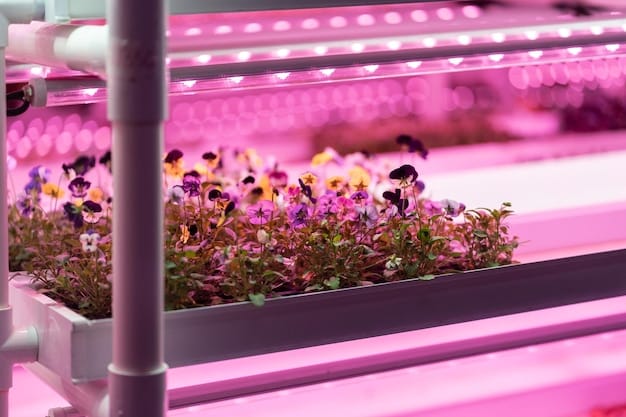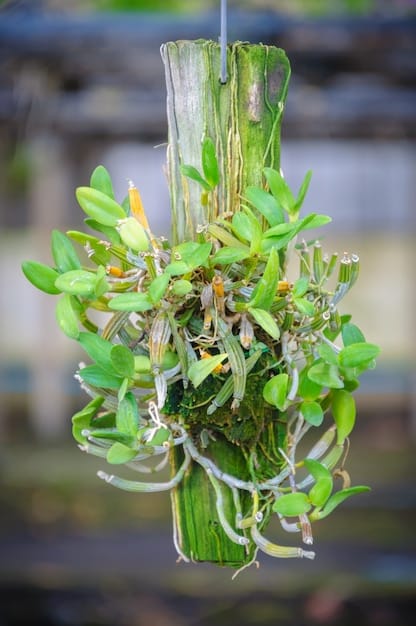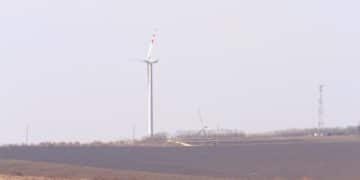Vertical Farms: Revolutionizing US Agriculture with Key Yield Innovations

Vertical farms are emerging as a potential solution to enhance agricultural productivity in the US, leveraging innovations in lighting, climate control, and nutrient delivery to achieve up to 30% higher yields compared to traditional farming methods.
Could the future of US agriculture be soaring upwards? Are Vertical Farms the Future of US Agriculture? Examining the 3 Key Innovations Driving 30% Higher Yields explores how these space-saving, high-tech farms are poised to revolutionize food production in America.
Understanding Vertical Farming: A New Era of Agriculture
Vertical farming represents a significant departure from traditional agricultural practices. By growing crops in vertically stacked layers within controlled indoor environments, these farms maximize space and resource efficiency. This approach offers a potential solution to some of the most pressing challenges facing modern agriculture, including land scarcity, water conservation, and climate change.
The concept of vertical farming isn’t entirely new, but recent technological advancements have made it more viable and scalable. Controlled environment agriculture (CEA) is at the heart of vertical farming, enabling precise control over temperature, humidity, lighting, and nutrient delivery. This level of control allows for optimized growing conditions, resulting in higher yields, reduced water consumption, and minimal pesticide use.
The Core Principles of Vertical Farming
At its core, vertical farming relies on several fundamental principles that differentiate it from traditional agriculture. These include:
- Controlled Environment: Maintaining optimal growing conditions through precise regulation of temperature, humidity, and air circulation.
- Vertical Stacking: Growing crops in stacked layers to maximize space utilization and increase overall yield per square foot.
- Soilless Growing Systems: Employing hydroponics, aeroponics, or aquaponics to deliver nutrients directly to plant roots, eliminating the need for soil.
These principles work in concert to create an efficient and sustainable food production system that can operate year-round, regardless of external weather conditions.
Ultimately, vertical farming aims to create a more resilient and sustainable food system. By minimizing environmental impact, optimizing resource use, and maximizing crop yields, vertical farms have the potential to transform the way we produce food in the 21st century. The integration of advanced technologies, such as AI and automation, further enhances the efficiency and scalability of these systems, paving the way for a new era of agriculture.

Key Innovation 1: Advanced LED Lighting Systems
One of the most critical innovations driving the success of vertical farms is the use of advanced LED lighting systems. Unlike traditional sunlight or conventional grow lights, LEDs offer precise control over the light spectrum, intensity, and duration, allowing growers to optimize photosynthesis and plant growth. Tailoring the lighting to specific crop needs can significantly enhance yield and quality.
LEDs are also far more energy-efficient than traditional lighting options. This is a crucial factor, given that lighting can account for a significant portion of the energy consumption in vertical farms. By reducing energy costs, LEDs make vertical farming more economically sustainable and environmentally friendly.
- Customizable Light Spectrum: LEDs can be tuned to emit specific wavelengths of light that are most beneficial for plant growth, maximizing photosynthesis and promoting healthy development.
- Energy Efficiency: LEDs consume significantly less energy compared to traditional grow lights, reducing operational costs and minimizing environmental impact.
- Extended Lifespan: LEDs have a longer lifespan than other lighting options, reducing the need for frequent replacements and minimizing maintenance costs.
The integration of advanced LED lighting systems is revolutionizing vertical farming by enabling growers to create optimized growing environments tailored to the specific needs of each crop. This precise control over lighting conditions leads to higher yields, improved quality, and reduced energy consumption, making vertical farming a more sustainable and efficient agricultural practice.
Key Innovation 2: Climate Control Technologies
Climate control is another essential aspect of successful vertical farming. These technologies regulate temperature, humidity, and air circulation, creating an optimal environment for plant growth. Precise climate control not only maximizes yields but also reduces the risk of pests and diseases, minimizing the need for pesticides and other interventions.
Advanced climate control systems often integrate sensors, automation, and data analytics to continuously monitor and adjust environmental conditions. This allows growers to fine-tune the growing environment in real-time, responding to changing plant needs and ensuring consistent, high-quality production.
Components of Climate Control
Several key components contribute to effective climate control in vertical farms:
- HVAC Systems: Heating, ventilation, and air conditioning (HVAC) systems regulate temperature and humidity levels, ensuring optimal growing conditions.
- Sensors and Monitoring: Sensors continuously monitor temperature, humidity, CO2 levels, and other environmental parameters, providing real-time data for informed decision-making.
- Automated Control Systems: Automated systems use data from sensors to adjust HVAC systems, lighting, and other environmental controls, maintaining consistent growing conditions.
“The ability to precisely control the climate within a vertical farm is a game-changer for agriculture,” says Dr. Emily Carter, an agricultural engineer at the University of California, Davis. “It allows us to create ideal growing conditions for a wide range of crops, regardless of external weather conditions.”

Key Innovation 3: Nutrient Delivery Systems
Efficient nutrient delivery is essential for maximizing plant growth and yield in vertical farms. Traditional soil-based agriculture relies on the complex interaction between soil, water, and nutrients to nourish plants. In contrast, vertical farms typically employ soilless growing systems such as hydroponics, aeroponics, or aquaponics to deliver nutrients directly to plant roots.
These soilless systems offer several advantages over traditional soil-based agriculture. They allow for precise control over nutrient levels, reducing waste and minimizing environmental impact. They also eliminate the risk of soilborne diseases and pests, reducing the need for pesticides and other interventions.
- Hydroponics: Plants are grown in nutrient-rich water solutions, providing direct access to essential minerals and elements.
- Aeroponics: Plant roots are suspended in air and periodically sprayed with nutrient-rich solutions, maximizing oxygen exposure and nutrient uptake.
- Aquaponics: Combines aquaculture (raising fish) with hydroponics, using nutrient-rich wastewater from fish tanks to nourish plants, creating a closed-loop system.
By optimizing nutrient delivery, vertical farms can achieve higher yields, improve crop quality, and reduce water consumption compared to traditional agriculture. The integration of advanced technologies like AI and machine learning further enhances the efficiency of these systems, allowing for real-time adjustments to nutrient levels based on plant needs.
| Key Element | Brief Description |
|---|---|
| 💡 LED Lighting | Customizable for optimal photosynthesis. |
| 🌡️ Climate Control | Precise regulation of temperature and humidity. |
| 🌱 Nutrient Delivery | Soilless systems for direct nutrient supply. |
| 💧 Water Usage | Reduced water consumption compared to traditional methods. |
Frequently Asked Questions
▼
Vertical farming is the practice of growing crops in vertically stacked layers, often indoors, using controlled-environment agriculture (CEA) technologies.
▼
Vertical farms increase yields by optimizing growing conditions, including lighting, temperature, humidity, and nutrient delivery, resulting in higher productivity per square foot.
▼
The main benefits include increased crop yields, reduced water consumption, minimal pesticide use, year-round production, and localized food production.
▼
Vertical farms can be sustainable by minimizing environmental impact, optimizing resource use, and reducing the need for long-distance transportation of food.
▼
Leafy greens like lettuce and spinach, herbs, and strawberries are examples of crops that thrive in controlled environments. Some vertical farms cultivate tomatoes, peppers and other vegetables as well.
Conclusion
In conclusion, vertical farming, propelled by advancements in LED lighting, climate control, and nutrient delivery systems, offers a promising avenue for enhancing agricultural productivity in the US. By addressing challenges like land scarcity and climate change, vertical farms have the potential to revolutionize the future of food production.





